Brief
 }
}
Auf einen Blick
- Conglomerates in India and Southeast Asia no longer hold an advantage in total shareholder returns over pure plays and have begun to underperform in revenue growth and margin improvement, according to our third conglomerates study.
- Unless conglomerates in these regions reinvent themselves, investors will call for breaking them up—the fate of many conglomerates in the West.
- However, the top performers have maintained a hefty conglomerate premium, showing a way to flourish: They have a clear ambition, articulate their parenting advantage, and make strategic portfolio and financial choices to deliver superior growth.
Bain & Company’s continuing research has analyzed the financial performance of Asia’s conglomerates since 2003. We released our first report in 2014, Teaching Dinosaurs to Dance, which focused on Southeast Asia’s conglomerates, and followed in 2016 with How Conglomerates in Southeast Asia Can Live Long and Prosper. Now, for our third comprehensive study, we have added India, another market dominated by conglomerates.
In total, we tracked the performance of 102 conglomerates and 287 pure plays (companies that focus on a single business) from 2003 to 2016. Our initial motivation for this research was to understand the “conglomerate paradox”—why conglomerates in Southeast Asia outperformed pure plays. Unlike their western counterparts, they delivered higher average total shareholder returns (TSR) than companies in Asia that focused on a single business. (TSR is defined as stock price changes assuming the reinvestment of cash dividends.)
We determined that Southeast Asia’s conglomerates had many things working in their favor. They benefited from easier and earlier access to opportunities, particularly rights to natural resources, the foundation of many conglomerates in the region. They held an advantage in everything from regulations to talent to capital.
However, in 2014, as we looked closer, we saw that as Asia’s markets developed, those benefits steadily diminished and the conglomerate premium compressed.
We predicted that further development of these Asian economies would continue to erode conglomerates’ historical economic advantages and financial performance. Ultimately, we determined, conglomerates in India and Southeast Asia would be forced to reinvent themselves and their sources of competitive edge in order to survive.
We envisioned a scenario in which the laws of strategic gravity would eventually prevail. As their markets matured and as their historical advantages—favors from regulators, better access to capital, first chances for opportunities, etc.—shrank, the best way to survive would be to evolve their portfolios to reach a sustainable leadership position in each of their businesses. However, achieving and sustaining market leadership in a level playing field requires more managerial and financial attention. Conglomerates would be forced to make strategic decisions involving where to focus their efforts.
Our 2016 research clearly confirmed the downward trend in conglomerate performance, and now the 2018 edition of our conglomerates report represents a turning point. For the first time in our 15 years of tracking performance, Asian conglomerates underperformed pure plays in their markets on core financial performance (see Figure 1). From 2007 to 2016, TSR dropped to 11% for conglomerates—slightly less than the 12% for pure plays, but enough to signal the changes ahead (see Figure 2). This should be a source of major concern. As conglomerates’ performance suffers, there will be calls from skeptical investors to break them up. That is what happened in the West. Moreover, if it happens in India and Southeast Asia, a doom loop will be set in motion: Conglomerates will be less able to attract talent, money and opportunities, further hurting their performance.

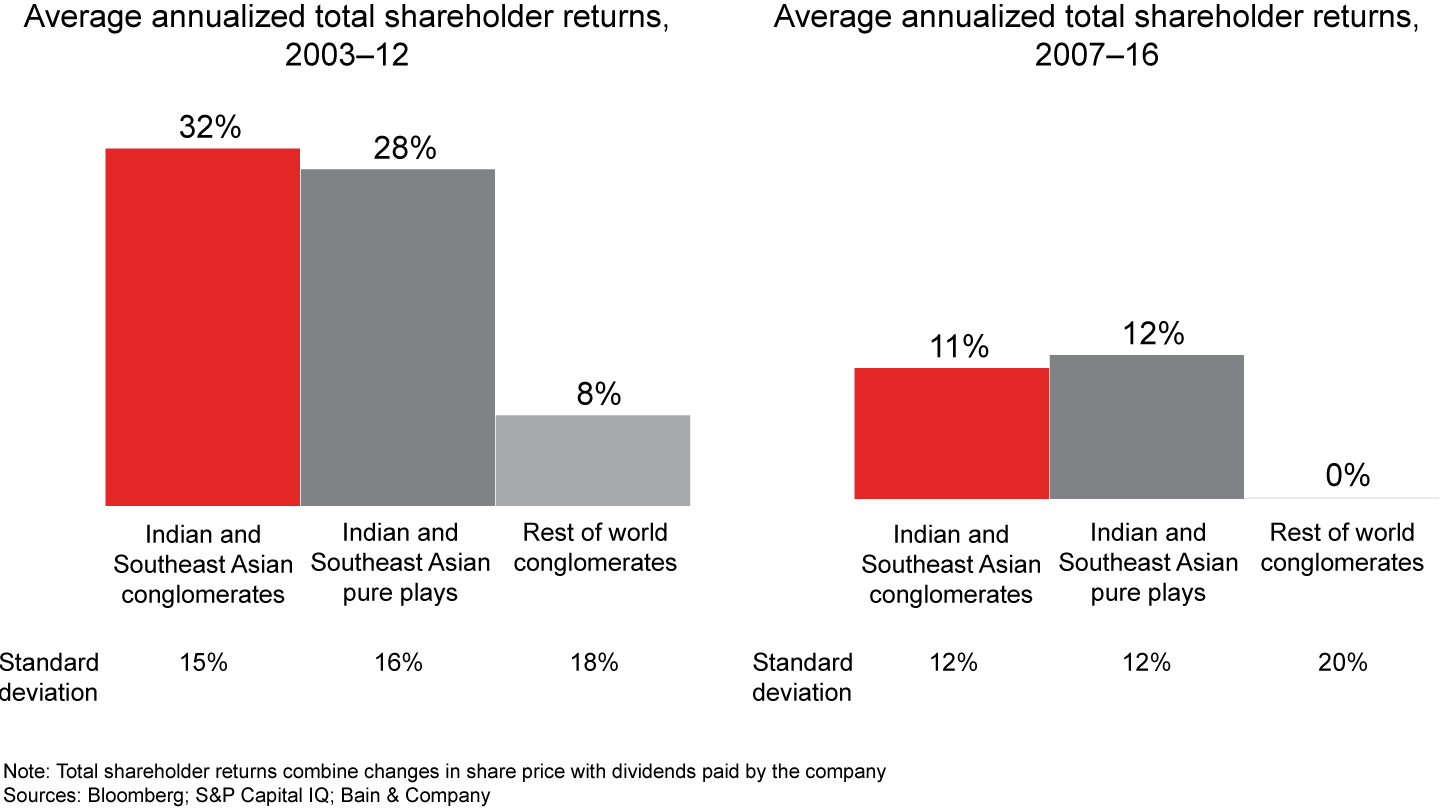
To avoid the bleak fate of their counterparts in the West, Asia’s conglomerates need to renew themselves—it’s especially critical in a time of digital disruption and rising competition from global technology powerhouses. Fortunately, they can look to the actions of the top-quartile performers, which have maintained a hefty conglomerate premium, to show the way. Indeed some conglomerates in the region have done especially well, outperforming pure plays by more than 13 percentage points on average, while the rest underperformed by an average 5 points (see Figure 3).
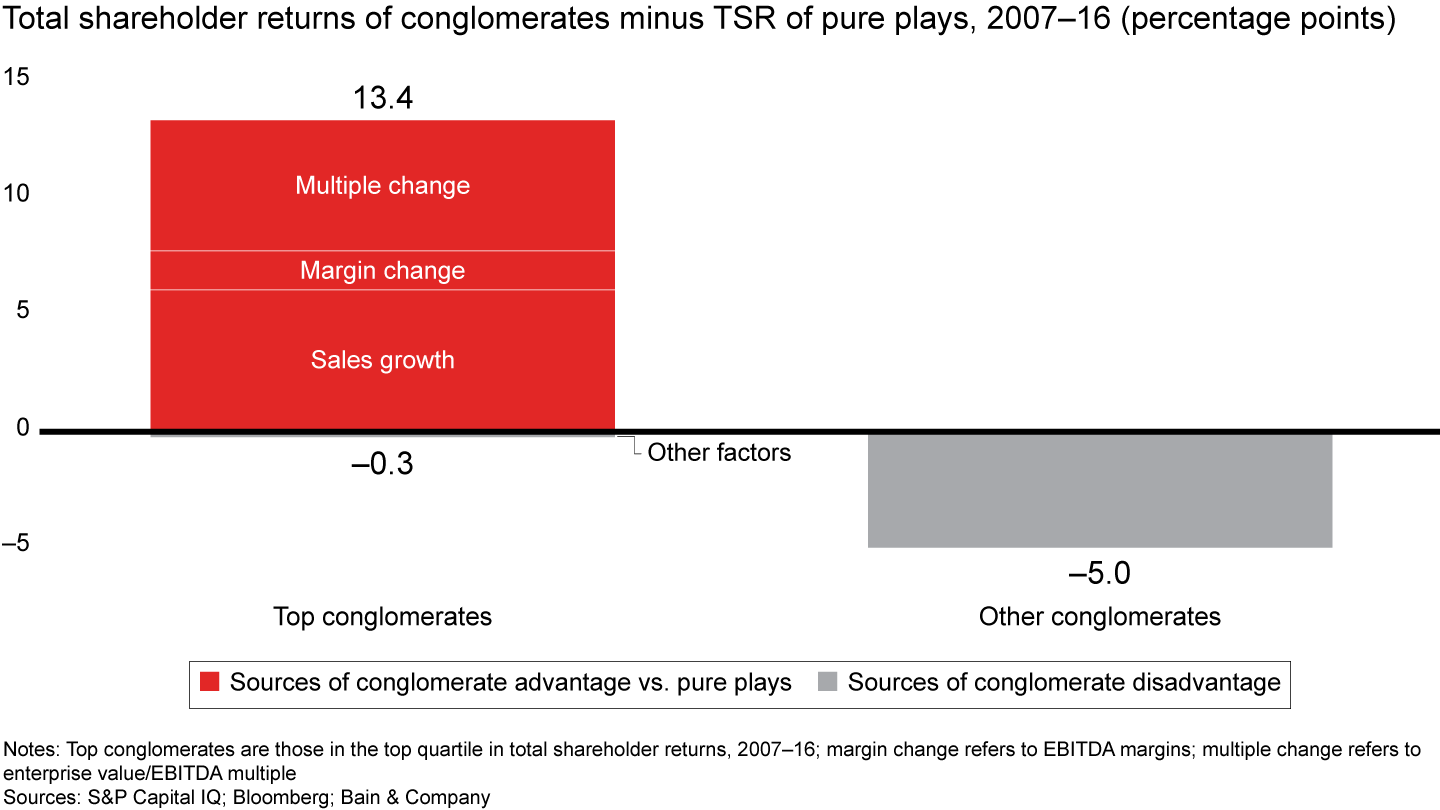
Who are these winners? Conglomerates like Thailand’s Charoen Pokphand Group and Berli Jucker Public Company, Malaysia’s Hap Seng Consolidated, India’s Bajaj Group, the Philippines’ DMCI Holdings and Indonesia’s Sinar Mas Group. All of these enjoyed annual TSR of 24% or more for the years 2007 to 2016 (see Figure 4). Indeed, top-quartile conglomerates in India and Southeast Asia performed significantly better than the others, achieving average TSR of 25% vs. −3% for the bottom quartile from 2007 to 2016.
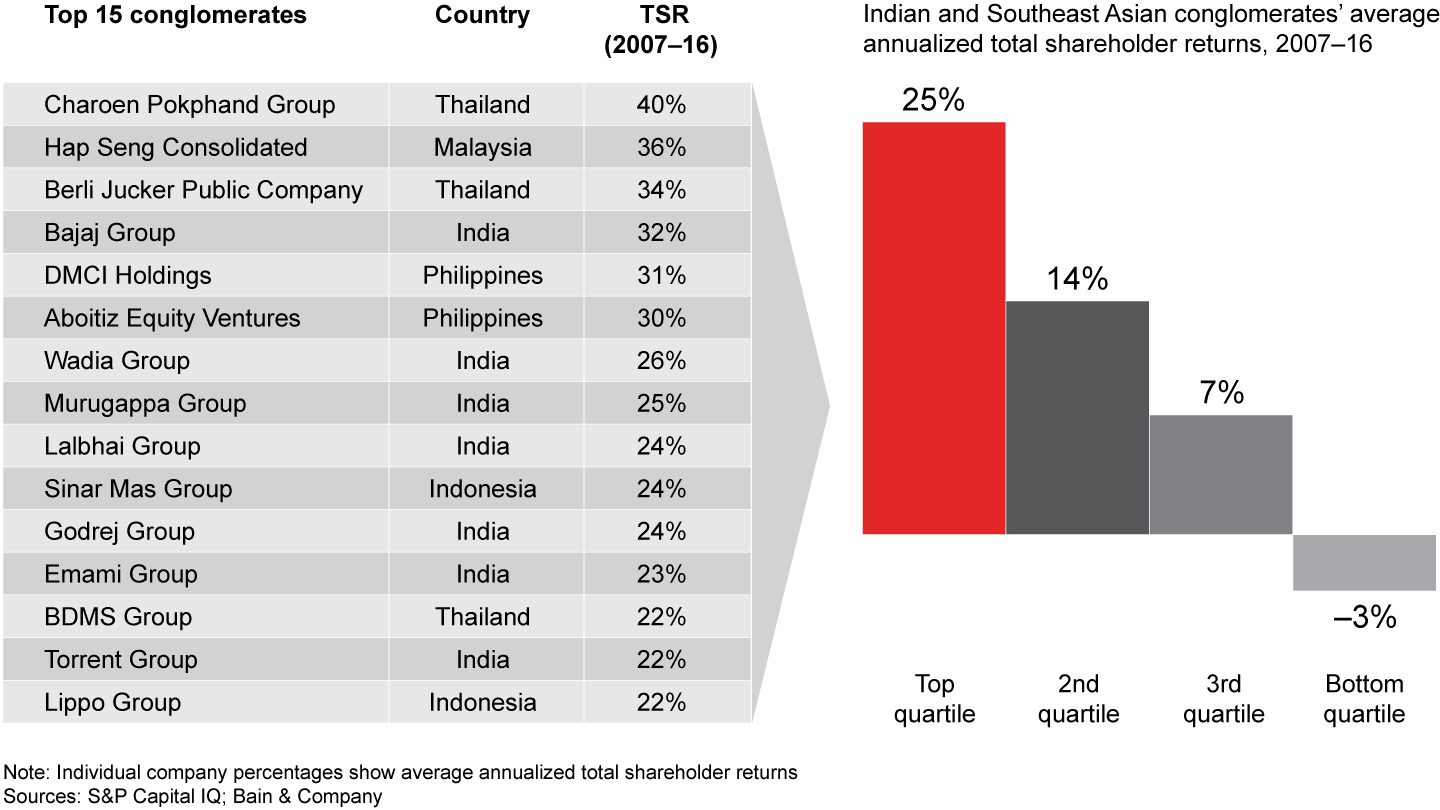
To understand the contributors to their TSR outperformance, we drilled down into six dimensions: sales growth, EBIDTA margin improvement, enterprise value/EBITDA multiple improvement, change in the number of shares, change in leverage and dividends. (The first three account for core enterprise value growth, and the latter three for capital structure change.) We found that these winners are differentiated based on their actual growth performance (sales more than margins) as well as expectations of future growth, as reflected in their multiple expansion (see Figure 5). Unlike lagging conglomerates, they avoided boosting dividends or balance sheet adjustments and focused on growing their businesses. This finding serves as a critical lesson for conglomerates hoping to stay relevant as their economies mature.
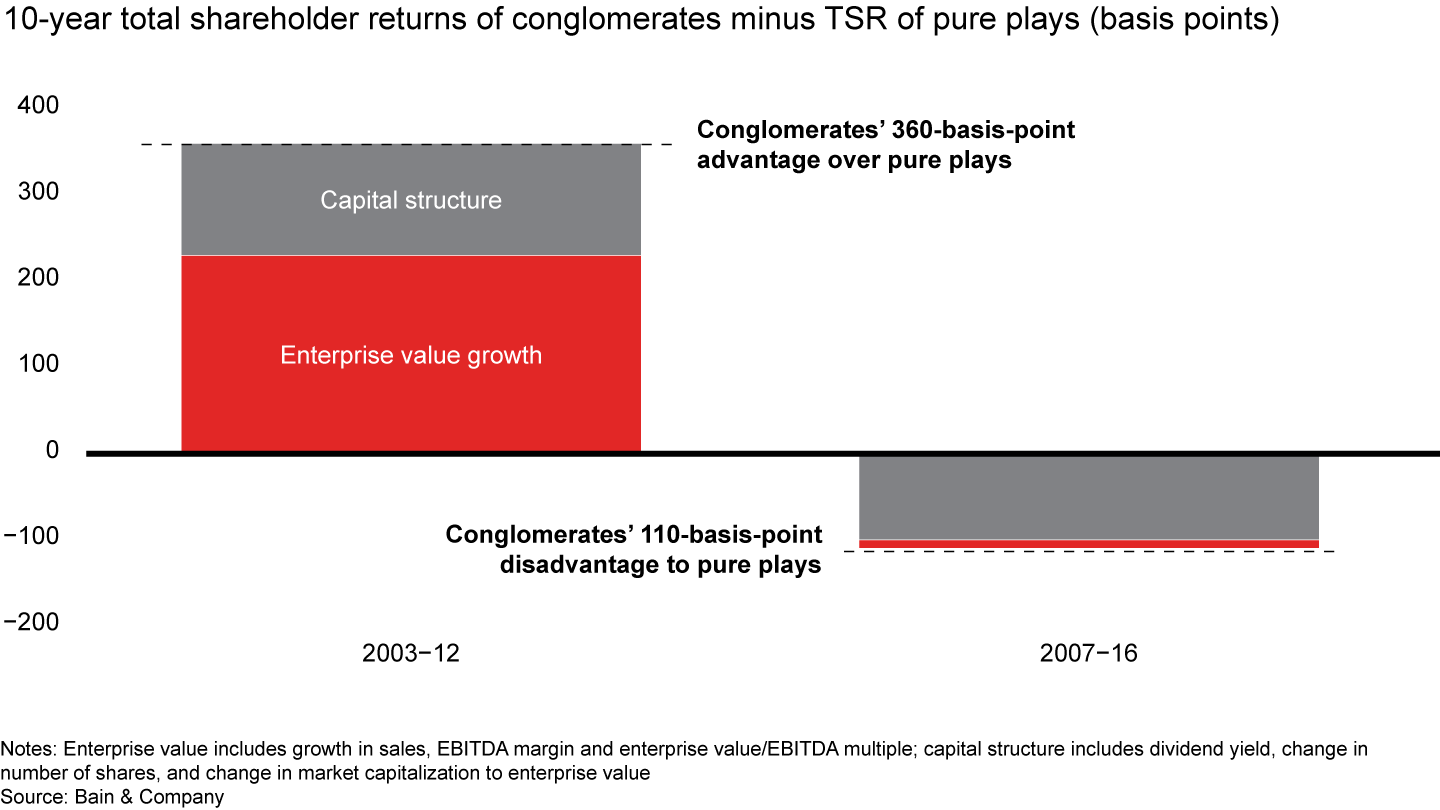
The encouraging news is that nearly half of the top-quartile conglomerates today were on the list five years ago. Remaining on top takes a focus on growth, and based on our ongoing global research and analysis in India and Southeast Asia, core business growth depends on a company’s ability to create a transformational roadmap in which they excel in four distinct areas (see Figure 6).
- a clear and compelling ambition that powers their existence as a conglomerate;
- a crisp articulation of their parenting advantage—the way a conglomerate adds value to each element of its portfolio;
- active management and resource allocation across the portfolio to drive profitable growth; and
- a well-thought-through financial strategy to fund their ambitions.
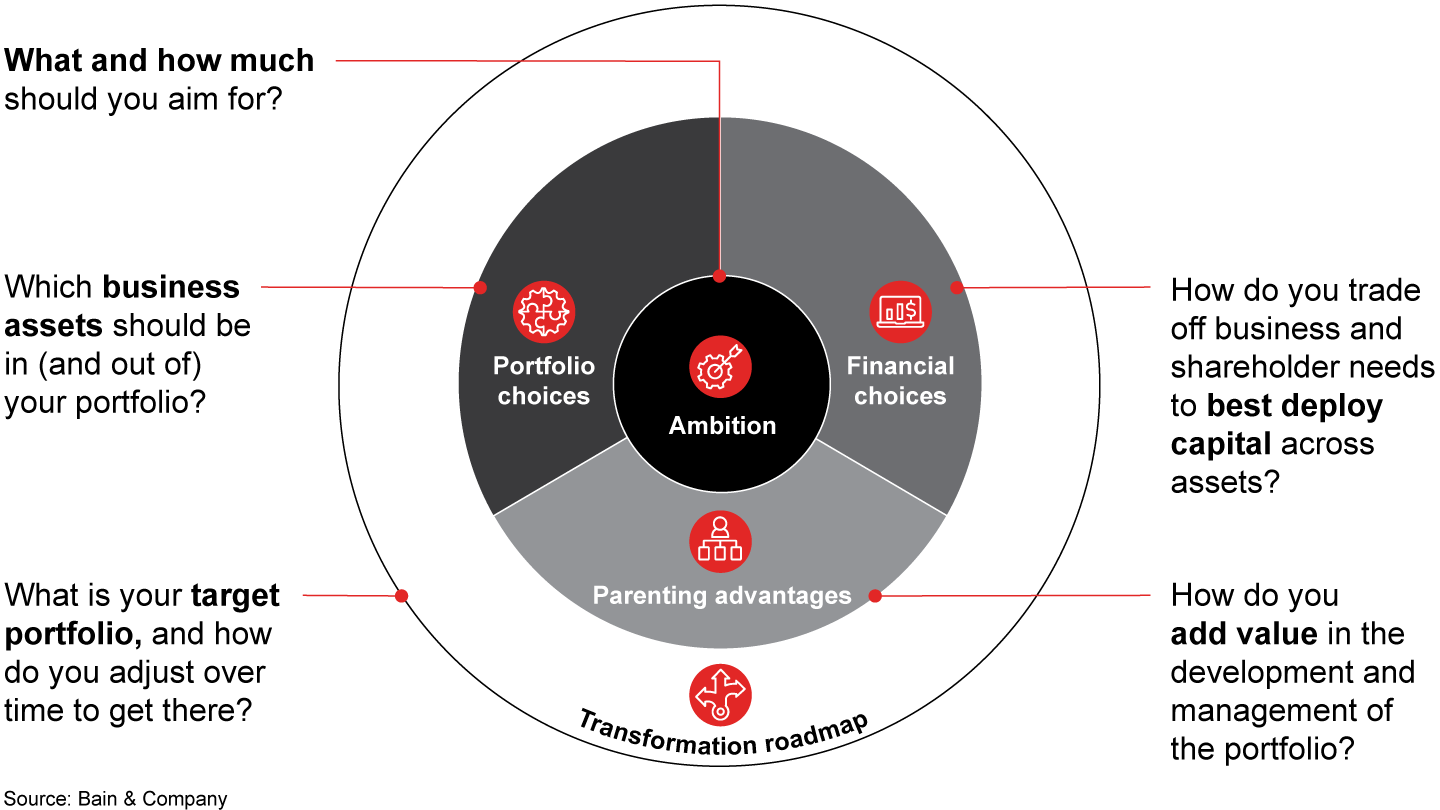
We’ll look at these one by one.
1. Find a compelling ambition
To reinvent themselves for a world in which they no longer hold an advantage over pure plays, conglomerates need to ask themselves: What is our purpose? What level of value creation should we aim for? Setting an ambition means different things for different conglomerates. For some, historically focusing on financial goals may have been sufficient, but today most conglomerates pursue a broader ambition. A compelling ambition needs to please three demanding (and sometimes contradictory) masters: it needs to provide the strategic clarity required to guide managerial decision making, inspire internal and external stakeholders, and offer a convincing investment rationale to investors. For the many Asian conglomerates that are family-owned or -controlled, this is doubly hard as they attempt to balance and reconcile family and corporate ambitions.
Thailand’s Charoen Pokphand Group is an example of a conglomerate with a socially oriented ambition: Create prosperity on three levels: countries, communities, the company and its people. Its sustainability goals include aggressive targets for reducing energy consumption, and it has a stated aim to provide employment for smallholder farmers, small and medium enterprises, and people in vulnerable groups. For its part, Larsen & Toubro has a more investor-oriented ambition. Its priorities include reallocating capital to businesses with visible value-creation potential, divesting noncore businesses and increasing transparency by listing subsidiaries.
2. Maintain a parenting advantage
The question sounds simple enough: How does the corporate center add value to the portfolio (over and above its cost)? As the initial advantages for conglomerates diminish, they need consciously to determine the parenting model that best suits them—the center as a hands-off portfolio manager, as a challenger of key decisions or as a hands-on integrator pursuing synergies across the portfolio. The best-fit model will depend on the similarity of the businesses in the portfolio—the degree of customer, cost and capability sharing, for example. It also will depend on the corporate capabilities that can add value, everything from manufacturing know-how to go-to-market proficiency to cultural advantages.
Best-in-class conglomerates evolve their parenting model as their portfolio mix and markets shift over time (see Figure 7). A case in point: Tata started out as a hands-on parent, known for maintaining central control. Over the decades, however, it became more detached, pruning its portfolio and concentrating on supporting the business units with access to capital or talent hired at the group level. Tata carefully evolved its parenting advantage. One area of focus for the center has been to strike the right balance between driving its core businesses to full potential (what we refer to as “Engine 1”) and reinventing its business for the future (“Engine 2”). Tata has been particularly effective at relying on its center to incubate companies for its Engine 2.
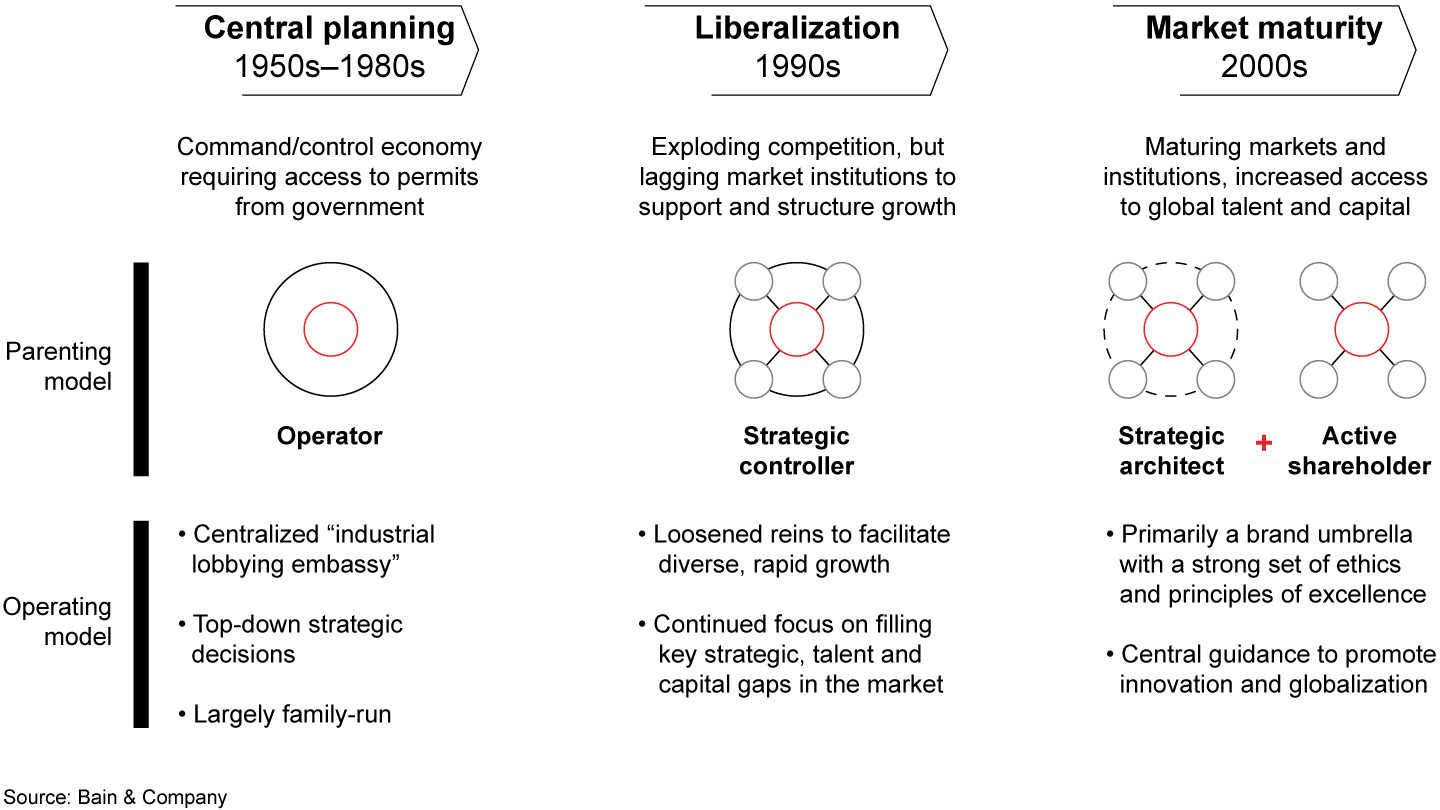
3. Enable growth across the portfolio
Top-quartile conglomerates achieve leadership position with both organic and inorganic growth, constantly pruning their portfolio to refocus on growth while looking for new opportunities. The best performers rigorously maintain focus and allocate resources differentially across businesses, while less successful conglomerates leave it to each business to determine its allocation of resources. The best performers also actively shape where and how to grow across the different businesses in their portfolio.
Growing beyond your home country. In our 2016 report, we argued that internationalization is fraught with pitfalls. Depending on the size and maturity of their home country, the best course of action for some conglomerates may be to remain resolutely local and to double-down on domestic opportunities. In our 2018 study, we conclude the same. Internationalization is a sustainable way to grow only when there is a clear path to achieving a leadership position in the countries entered.
Consider the situation with Berli Jucker. The conglomerate successfully expanded to Vietnam and Malaysia, but did so only after achieving leadership position in its home market of Thailand. Its objective is to become the leader in any market it enters—as it has in Vietnam and Malaysia in glass packaging.
San Miguel, on the other hand, has learned to focus on its home market, the Philippines. In 2001 to 2005, the conglomerate expanded into Australia by acquiring two Australian businesses. However, in 2007 and 2008, it reversed that strategy by selling those assets while simultaneously doubling down in the domestic market with two local companies—a 27% stake in utility company Meralco and a 50% stake in oil refiner Petron. San Miguel’s international strategy delivered 50% growth from 2001 to 2007. The domestic approach proved much more successful, resulting in 240% growth from 2007 to 2011. Since 2011, the company has been selectively expanding internationally.
Turning to M&A. Our experience shows that nonorganic growth becomes increasingly critical for fulfilling a company’s growth ambitions. However, conglomerates in Southeast Asia still appear lukewarm toward acquisitions. About 60% of the conglomerates we surveyed conduct less than one deal a year on average, and 40% of those deals are valued at less than $20 million. In our experience, M&A is a learned skill, with frequent acquirers substantially outperforming infrequent acquirers. Conglomerates that executed 10 or more deals (acquisitions or divestments) achieved a median TSR of 14% from 2012 to 2016, while nonacquirers achieved a median TSR of −4% during the same period.
Godrej, one of India’s leading conglomerates, has repeatedly used M&A to grow. It acquires at least one company every year, and in 2010 set an internal record by making nine acquisitions. M&A has helped Godrej expand into new markets such as East Africa, while building leadership in India.
The growing importance of Engine 2. Amid digital disruption and other fast-paced changes, conglomerates need to stay relevant. One way is to incubate new businesses as part of their Engine 2 strategy. The best conglomerates acknowledge that incubation requires a different operating model than running a core business. For example, it calls for a different level of autonomy and decision rights that may take years to generate material revenue contributions.
Therefore, successful conglomerates create two operating models: one for running the core business and the other for incubation. Google has articulated this reality in the form of its “70-20-10” rule. The company spends 70% of its resources on its core business, 20% on businesses with near-term potential and 10% on longer-term bets—those “moon shot” initiatives are incubated to grow into its Engine 2.
Arguably, conglomerates may be better positioned than pure plays to nurture an Engine 2. They already know the tricks of running businesses with different operating models, and their diversification protects them somewhat from the risks of disruption to any particular business. Consider how Kalbe was able to use its conglomerate structure to dramatically shift its core business over the years. Founded in 1966 as a pharmaceuticals business, it expanded heavily into health and nutrition in the early 2000s, to the point that the “new” business now generates more than half of Kalbe’s revenues. Another growing approach: leading conglomerates such as Sinar Mas, RPG and Lippo create venture capital arms to seed new bets from the center.
When divestitures or spinoffs make sense. Divesture is another critical lever for conglomerates to outperform and stay relevant. Yet many conglomerates in Asia have a deeply embedded “buy and hold” mentality and are reluctant to exit a business even if it offers limited upside. They rarely consider the opportunity costs involved in carrying on with an underperforming business—in capital, in human resources and, most important, in management time. Divestment was used by 67% of the outperforming companies in our survey.
Our research shows that focused divestment has a positive impact on conglomerates’ TSR. Divestitures that strategically clean up a company’s portfolio and command an optimal price can generate shareholder value for both buyer and seller.
Our research on divestiture has found that companies achieve better results when they take a four-step approach to divestiture (see the Bain Brief “Everybody Wins in Divestitures,” June 2017). They proactively and thoughtfully select the right assets to divest. In addition, they earn higher multiples by investing the time, talent and money required to make a business attractive for sale, instead of waiting until it is too late and selling quickly. The best divesting companies also run a smooth selling process that clearly communicates value to buyers. In addition, they ultimately implement a low-risk carve-out program aimed at minimizing execution costs and future stranded costs.
Divestitures involve the sale of a part of the business to a third party. Another option is to create a spinoff—a public listing of a part of the business, with shares of the newly created company distributed to shareholders. Sime Darby’s spinoff experience best illustrates the benefits of doing it right. When the conglomerate restructured itself by creating three more-focused public companies (Sime Darby Berhad, Sime Darby Property Berhad and Sime Darby Plantation Berhad), shareholders reacted positively.
4. Make the best financial choices
Top-quartile conglomerates differentiate themselves from their counterparts in how they deploy capital. They focus on investing in growth over providing dividends and are able to convince shareholders about their prospects for future growth. For Larsen & Toubro, a compelling equity story validated its strategy to investors and investment banks. Investment banks praised its diverse business model and productive management, to the point that both its EV/EBITDA and PE ratios outperformed the median for both conglomerates and pure plays in India. Key to a conglomerate’s success is its ability to pursue the right funding mechanism, whether it is equity funding, debt finance, project finance or joint ventures and other forms of partnership.
Assessing and rearticulating these four pillars of corporate strategy are the first steps for any conglomerate hoping to stay relevant and thrive in the decades ahead. This simple checklist can help companies get started on that path:
A checklist for reinventing conglomerates
- Do we have a well-defined ambition that sets out our value-creation plan and mission of the company?
- Do we have clear parenting advantages to guide portfolio choices and the group’s value-added to assets?
- Do we have a clear perspective on the full potential of existing assets?
- Organic full potential
- Ways to strengthen the market position through acquisitions
- Ways to expand the boundaries to grow into adjacencies through acquisitions
- Do we have an outside-in perspective of our portfolio?
- Attractive industries outside of the existing portfolio that we could invest in
- Whether we are the best owner of existing assets and which assets we would consider divesting
- Trade-offs between existing assets and expansion opportunities
- Do we have a roadmap toward the target portfolio in place?
- Do we understand the collective risk of our portfolio, and how different portfolio choices would change that?
- Have we defined a clear equity story and how to communicate it to investors?
- Do we have key enablers in place to bring all business units to full potential?
- Well-defined operating model
- Performance dialogue

Front Line of Healthcare Report 2018
Unzufriedenheit von Klinikärzten nimmt alarmierende Formen an.
Jean-Pierre Felenbok is a Bain & Company partner based in Jakarta, Nikhil Prasad Ojha is a Bain partner based in Mumbai, and Sharad Apte is a partner in Bangkok. Till Vestring is an advisory partner, and Thomas Olsen is a Bain partner. Both are based in Singapore.






